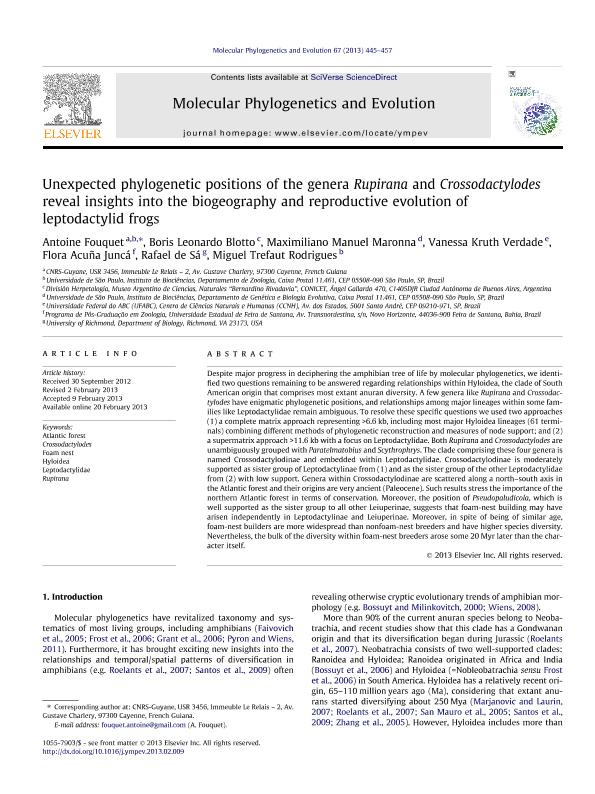Artículo
Unexpected phylogenetic positions of the genera Rupirana and Crossodactylodes reveal insights into the biogeography and reproductive evolution of leptodactylid frogs
Fouquet, Antoine; Blotto Acuña, Boris Leonardo ; Maronna, Maximiliano Manuel; Verdade, Vanessa Kruth; Acuña Juncá, Flora; De Sá, Rafael; Rodrigues, Miguel Trefaut
; Maronna, Maximiliano Manuel; Verdade, Vanessa Kruth; Acuña Juncá, Flora; De Sá, Rafael; Rodrigues, Miguel Trefaut
 ; Maronna, Maximiliano Manuel; Verdade, Vanessa Kruth; Acuña Juncá, Flora; De Sá, Rafael; Rodrigues, Miguel Trefaut
; Maronna, Maximiliano Manuel; Verdade, Vanessa Kruth; Acuña Juncá, Flora; De Sá, Rafael; Rodrigues, Miguel Trefaut
Fecha de publicación:
05/2013
Editorial:
Academic Press Inc Elsevier Science
Revista:
Molecular Phylogenetics and Evolution
ISSN:
1055-7903
Idioma:
Inglés
Tipo de recurso:
Artículo publicado
Clasificación temática:
Resumen
Despite major progress in deciphering the amphibian tree of life by molecular phylogenetics, we identified two questions remaining to be answered regarding relationships within Hyloidea, the clade of South American origin that comprises most extant anuran diversity. A few genera like Rupirana and Crossodactylodes have enigmatic phylogenetic positions, and relationships among major lineages within some families like Leptodactylidae remain ambiguous. To resolve these specific questions we used two approaches (1) a complete matrix approach representing >6.6 kb, including most major Hyloidea lineages (61 terminals) combining different methods of phylogenetic reconstruction and measures of node support; and (2) a supermatrix approach >11.6 kb with a focus on Leptodactylidae. Both Rupirana and Crossodactylodes are unambiguously grouped with Paratelmatobius and Scythrophrys. The clade comprising these four genera is named Crossodactylodinae and embedded within Leptodactylidae. Crossodactylodinae is moderately supported as sister group of Leptodactylinae from (1) and as the sister group of the other Leptodactylidae from (2) with low support. Genera within Crossodactylodinae are scattered along a north–south axis in the Atlantic forest and their origins are very ancient (Paleocene). Such results stress the importance of the northern Atlantic forest in terms of conservation. Moreover, the position of Pseudopaludicola, which is well supported as the sister group to all other Leiuperinae, suggests that foam-nest building may have arisen independently in Leptodactylinae and Leiuperinae. Moreover, in spite of being of similar age, foam-nest builders are more widespread than nonfoam-nest breeders and have higher species diversity. Nevertheless, the bulk of the diversity within foam-nest breeders arose some 20 Myr later than the character itself.
Palabras clave:
ATLANTIC FOREST
,
CROSSODACTYLODES
,
FOAM NEST
,
HYLOIDEA
,
LEPTODACTYLIDAE
,
RUPIRANA
Archivos asociados
Licencia
Identificadores
Colecciones
Articulos(MACNBR)
Articulos de MUSEO ARG.DE CS.NAT "BERNARDINO RIVADAVIA"
Articulos de MUSEO ARG.DE CS.NAT "BERNARDINO RIVADAVIA"
Citación
Fouquet, Antoine; Blotto Acuña, Boris Leonardo; Maronna, Maximiliano Manuel; Verdade, Vanessa Kruth; Acuña Juncá, Flora; et al.; Unexpected phylogenetic positions of the genera Rupirana and Crossodactylodes reveal insights into the biogeography and reproductive evolution of leptodactylid frogs; Academic Press Inc Elsevier Science; Molecular Phylogenetics and Evolution; 67; 2; 5-2013; 445-457
Compartir
Altmétricas



